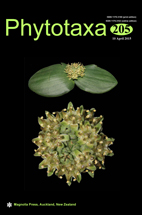Abstract
Eugenia sect. Racemosae (Myrtaceae) includes about 59 species of shrubs and trees native to the Neotropics. Members of the section range from northern Mexico and the Antilles throughout South America to Uruguay and northern Argentina. Most species are trees, found in several vegetation types. The section as treated here contains species with flowers exclusively in racemes and/or rarely diplobotrys (compound inflorescence with racemose partial inflorescences), with an obvious flower-bearing axis with a pedicel to internode ratio of 2:1 or less. All typification and nomenclatural issues pertaining to the section and its component species are comprehensively examined here. Eugenia sect. Racemosae is monophyletic, as showed by previous studies. Thirty five names are lectotypified where necessary; many of these taxa were described from collections in Berlin (B) that are no longer extant. This study also provides other nomenclatural notes of species of Eugenia sect. Racemosae, such as a new synonym and a new combination. A new name for Eugenia macrophylla O. Berg is also proposed.

